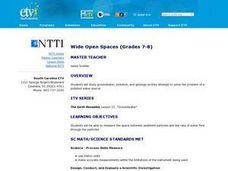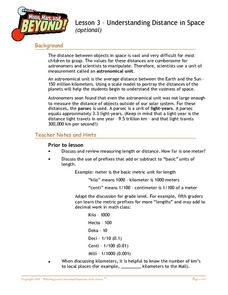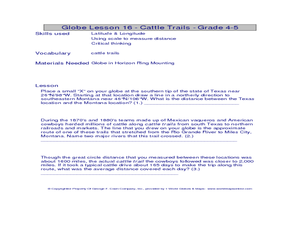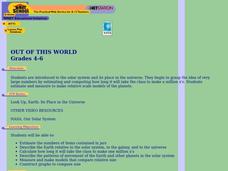Curated OER
Shake, Rattle and Erode
Students measure how much mass is worn away during 15-20 minutes of shaking. They shake rocks for 15-20 minutes to simulate stream erosion. Students listen to music as they shake their rocks. They weigh out 100 grams of marble chips....
American Museum of Natural History
What Do You Know About PaleontOLogy?
Believe it or not, some dinosaurs are not extinct. Discover this and other interesting facts about dinosaurs in a 10-question online quiz. As individuals answer questions, the resource provides them with feedback and additional facts...
Curated OER
Global Change: Where Land, Air and Water Meet
Students discuss the atmosphere as a mixture of gases. In this science lesson, students explore the world's oceans and fresh waters understanding that there are dissolved chemicals. Students realize that many substances dispersed in air...
Curated OER
Wide Open Spaces
Students examine the problem of groundwater pollution. In groups, they develop a solution to solve the problem of a local polluted water source. They also practice measuring the space between sediment particles and the rate of water flow.
Curated OER
Living in Base Ten
Students explore scientific notation and the structure of the metric system. In this middle school mathematics lesson, students read How Much is a Million? by David M. Schwartz to introduce students to the need for scientific...
Curated OER
Solar System Bead Distance Activity
Students create a scaled solar system model using colorful beads. In this space science lesson, students convert AU units into metric measurements. They arrange the planets according to their distances from the sun.
Curated OER
Understanding Distance in Space
Young scholars discover the vocabulary used for distances in space and review measurement units and instruments before creating a scale model of the planets. They determine how to calculate the relative distances between the planets...
Curated OER
Observations and Inferences
Students observe how to distinguish observations form inferences. In this examining inferences instructional activity students list observations relating to the activity and discuss the importance of them.
Curated OER
Cattle Trails
Students identify and locate cattle trails on a globe. In this map skill lesson, students use a marker to locate Texas and Montana and use the map scale to calculate the distance of the cattle trail.
Curated OER
Bread in a Bag
This lesson focuses on making bread, but also spends some time on the origins of wheat. In order to make the bread, each class member receives a kit full of the materials they will need. Included here is a detailed list of instructions...
Curated OER
Tracking Current "Earth" Events
Eighth graders utilize Internet research skills, and practice their communication skills by presenting their research to the clas. They actively consider the types of hazards for humans associated with Natural Disaters and ways that...
Curated OER
Scientific Notation
For this algebra worksheet, students identify the correct method to write positive and negative exponents. They solve word problems and write in scientific notation. There are 21 questions with an answer key.
Curated OER
An Early American Culture
Learners identify the locations of the Hopewell culture. In this map skills lesson, students use a globe to mark several locations of the Hopewell culture.
Curated OER
Flickr of Idea on a Gaming Project Led to Photo Website
Students explore the concept of technology. In this technology lesson, students read an article about the creator of Flickr. Students discuss how Flickr grabs the attention of its audience. Students describe a technology that they think...
Curated OER
Fertilizers, Pesticides and Health
Students apply real data to create and calculate algebraic equations. Students create a visual to represent the concentration for one part per million and apply unit analysis to verify measurement computations. Students define the use...
Curated OER
Out of This World
Students are introduced to the solar system and its place in the universe. They begin to grasp the idea of very large numbers by estimating and computing how long it take the class to make a million x's.
Curated OER
History of Our Solar System Time Line
Ninth graders explore the concept of ratios. In this ratio lesson, 9th graders construct a to scale time line that starts at the beginning of time. Students determine the correct placement of big events in time such as when the dinosaurs...
Curated OER
The Time of Man
Young scholars demonstrate visually Mankind's relative place on the earth's timeline. They familiarize themselves with the use of the metric system in measuring and producting a timeline.
Curated OER
Spotlight on Canada
For this Canadian facts worksheet, students use the Internet or library to help them respond to 15 short answer, multiple choice, and true or false questions.
Curated OER
Biodiversity
Students match certain animals with a possible fate that could happen to them from a provided list in order to discover the threats to biodiversity and the role humans play. They also discover the importance of biodiversity and what we...
Curated OER
Quiz: Astronomy
In this science worksheet, 3rd graders will focus on various aspects of astronomy. Students will respond to ten questions all pertaining to stars, constellations, planets, and our solar system.
Curated OER
Understanding Pi.
Students study the relationship between circumference and diameter to come up with Pi. "In this pi instructional activity, students measure, record and find the ratio "circumference/diameter" and their average which is an approximation...
Curated OER
Over 5 digit number word problems
In this over 5 digit numbers worksheet, students complete word problems involving numbers over 5 digits having to do with measurement, place value, and more. Students complete 10 problems.
Curated OER
Dinosaur Prints
Students examine dinosaur footprints and compare them to the shape of elephant footprints and to the size of their own footprints.























